Abortions will continue, but might be harder to access safely.
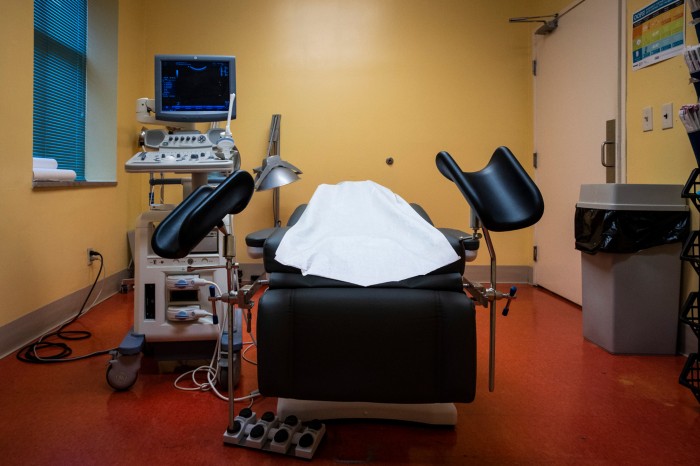
Abortion clinics around the United States are facing an uncertain future.
In June, the US Supreme Court ruled that the constitution does not confer the right to an abortion. Now, 13 states have greatly restricted access to the procedure, and about a dozen more are expected to follow suit.
For a high-income country to take such a giant leap towards prohibiting what many people consider a basic human right is nearly unprecedented. Health researchers are scrambling to predict the effects of such changes. Most experts expect that abortions will continue to happen, but will be harder to obtain legally — sometimes requiring extensive travel — and could become less safe. Less certain are the long-term effects on abortion rates, public health and pregnant people’s economic prospects. “If people want me to extrapolate from prior evidence to what’s going on now, I don’t think there’s any comparable evidence,” says sociologist Jonathan Bearak at the Guttmacher Institute, a policy group in New York City focused on sexual and reproductive health rights.
As the United States hurtles into the unknown (see ‘Changing landscape’), evidence suggests that enacting abortion restrictions will create substantial burdens, both for people seeking abortions and for the clinics that continue to offer these procedures.
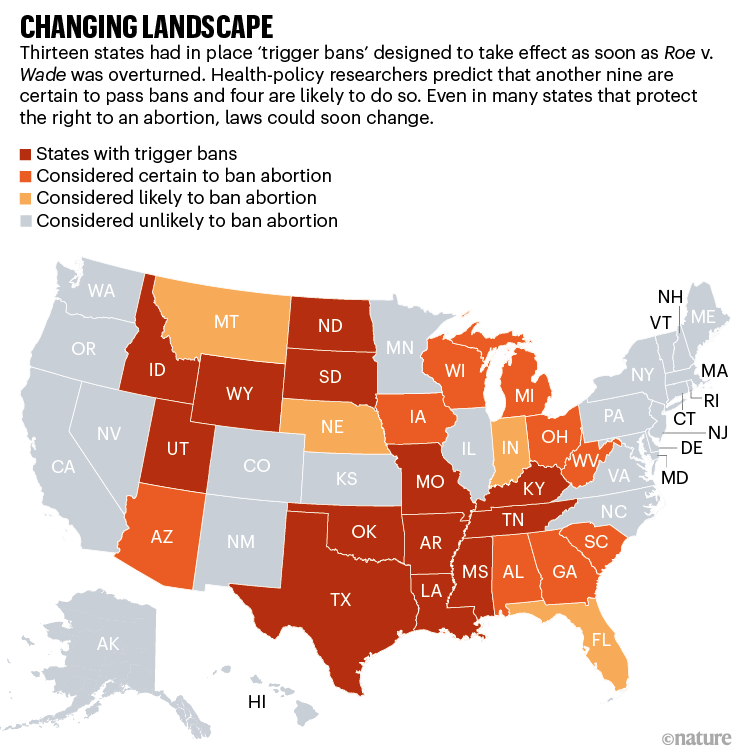
Source: Guttmacher Inst.
For a high-income country to take such a giant leap towards prohibiting what many people consider a basic human right is nearly unprecedented. Health researchers are scrambling to predict the effects of such changes. Most experts expect that abortions will continue to happen, but will be harder to obtain legally — sometimes requiring extensive travel — and could become less safe. Less certain are the long-term effects on abortion rates, public health and pregnant people’s economic prospects. “If people want me to extrapolate from prior evidence to what’s going on now, I don’t think there’s any comparable evidence,” says sociologist Jonathan Bearak at the Guttmacher Institute, a policy group in New York City focused on sexual and reproductive health rights.
As the United States hurtles into the unknown (see ‘Changing landscape’), evidence suggests that enacting abortion restrictions will create substantial burdens, both for people seeking abortions and for the clinics that continue to offer these procedures.

Source: Guttmacher Inst.
Abortions won’t stop
Evidence from around the world suggests that restricting abortion doesn’t put an end to it. In fact, sometimes the opposite is true. Bearak and Bela Ganatra, a behavioural scientist at the World Health Organization (WHO) in Geneva, Switzerland, and their colleagues compiled 2,415 data points, including survey results and health records, to estimate the number of unwanted pregnancies and the rate of abortions in 195 countries and territories around the world. The analysis found that high-income countries where abortion is broadly legal have the lowest rates of abortion (see ‘Legality and reality’).
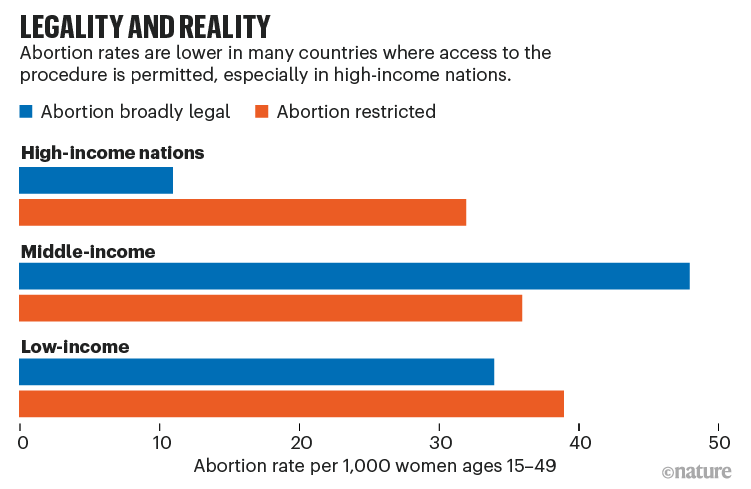
Source: Ref. 1
Middle-income countries were particularly telling in this analysis: their rates of unintended pregnancies were similar, irrespective of the legal status of abortion in the country. However, restricting access seems to cut the rate of abortion by only about 25%. “It’s not that people’s reproductive intentions change when you put in restrictions,” Ganatra says. “They will try to do what they’ve decided to do.”
Access will become harder
Caitlin Myers, an economist at Middlebury College in Vermont, maintains a database of facilities that provide abortion services. The average travel distance for those seeking care at a clinic in the continental United States doubled, to around 80 kilometres, just two weeks after the Supreme Court overturned Roe v. Wade, the 1973 decision that had protected the legality of abortion. If all states that are at high risk of banning abortion do so, this distance is expected to increase to about 217 kilometres.
If this situation comes to pass, roughly 24 million women between the ages of 15 and 44 will see increases in travel distance in excess of 160 kilometres, according to the data Myers has collected (see ‘Going the distance’). That’s more than one-third of the people in that demographic.
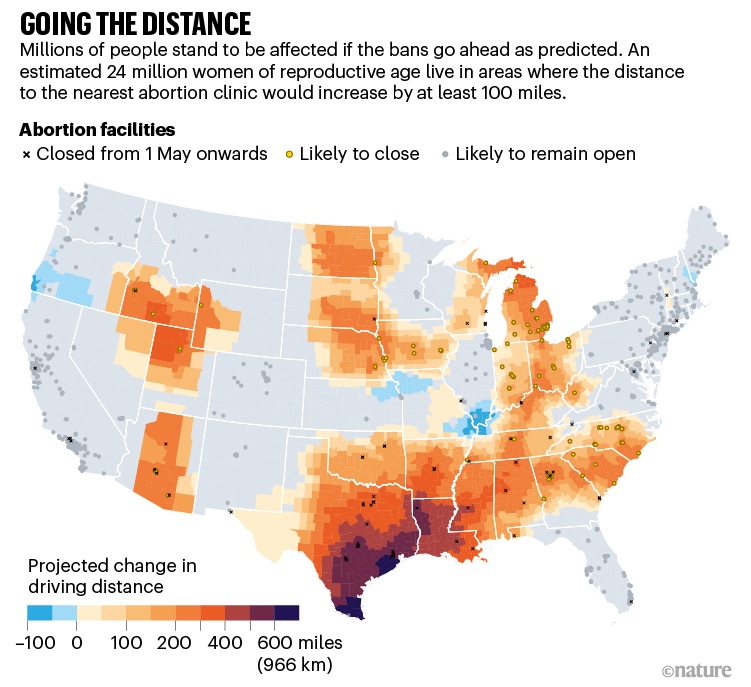
Source: Caitlin Myers, Middlebury College
Many current destination states are places where the future of abortion is unclear, such as Florida, so providers in these states might avoid putting resources into increasing capacity. “There’s a lot of questions that are likely going through providers’ minds,” Myers says.
Neighbouring states will be affected
Some of the greatest distances that people already travel for legal abortions are in Texas, a large state that has been increasing restrictions on the procedure for more than a decade. And although some people will turn to mail-order medications or other clandestine methods to end a pregnancy, many will travel to clinics in other states.
Public-health researcher Kari White at the University of Texas at Austin and her colleagues have measured the burden that abortion restrictions place on these clinics. Here, recent history is informative.
Last year, Texas passed a law banning the procedure once a fetal heartbeat can be detected — a very early stage at which many might not even be aware they are pregnant. As a result, the number of Texas residents travelling out of state to obtain abortions increased more than tenfold, with particular increases in those going to the neighbouring states of Oklahoma and New Mexico. (Oklahoma is one of the states expected to further tighten its restrictions.)
White and her colleagues found that, after the law was introduced, some clinics in states adjacent to Texas were reporting wait times of around three weeks and some were no longer making appointments (see ‘Increased waiting times’). Meanwhile, the number of abortions performed in Texas dropped by almost half — from 4,313 in September 2020 to 2,164 in September 2021.
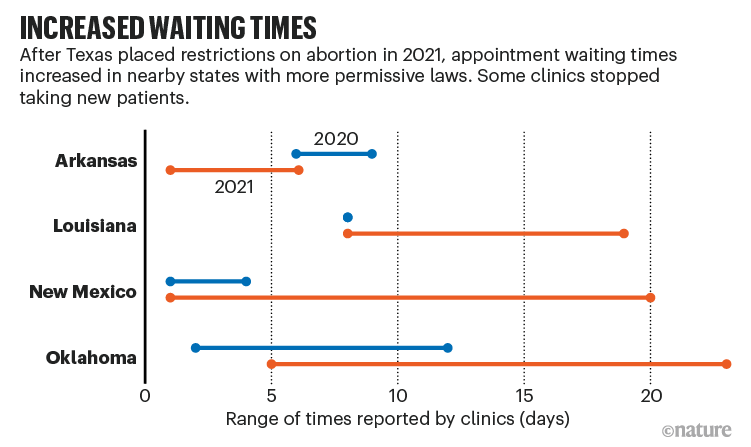
Source: K. White et al. Initial Impacts of Texas' Senate Bill 8 on Abortions in Texas and at Out-of-State Facilities. Research Brief (2021), available at go.nature.com/3DHQZQO
“Once Texas bans abortion altogether, the number of patients travelling out of state each month will skyrocket,” says Ushma Upadhyay, a public-health scientist at the University of California, San Francisco. Sociologist Nicholas Mark at New York University in New York City says that this trend is likely to become more difficult to study in the near future, as people become less likely to divulge details about their abortions.
People will be hit financially
Surveys have shown that many women in the United States request abortions because they lack the financial means to support a child. But understanding the economic impact on people who are denied abortions has been an enduring challenge.
In the Turnaway Study, researchers at the University of California, San Francisco, tracked hundreds of women from around the United States who either received abortions close to the gestational limit in their area or were denied the procedure because they were just over the limit.
The two groups differed in some ways — those who were denied abortions tended to be younger, less likely to already have children, more likely to be unemployed and more likely to be living with other adult family members — but, Ganatra says, the study is a reasonable approach for tackling the complex circumstances that lead people to request abortions.
In one analysis of the Turnaway data, just over half of women in the study were living below the federal poverty line when they requested an abortion, and being denied one led to a fourfold increase in the odds that their household income would fall below the federal poverty line.
In 2020, an analysis that linked credit data to the Turnaway Study found that women who had been denied an abortion had 78% more debt that was at least 30 days overdue and 81% more negative public records, such as bankruptcies and evictions, compared with those who received abortions. Women who went on to give birth scored more highly on an index of financial distress, which incorporates events such as having debt sold to a collection agency or having a credit score that drops below 600 (see ‘Financial insecurity’). According to the authors of the study, “Being denied an abortion has large and persistent negative effects on a woman’s financial well-being.”
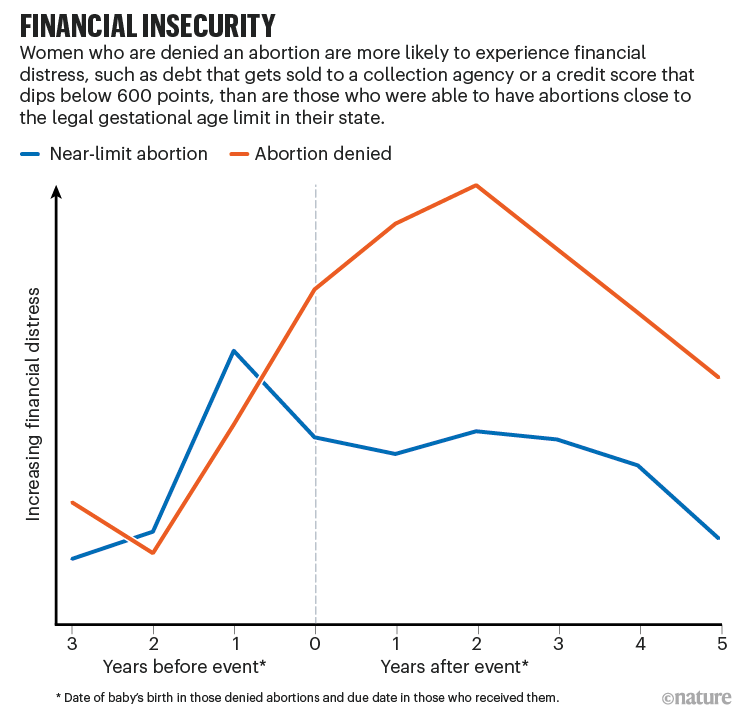
More abortions could be unsafe
Abortions won’t stop, but global data indicate that they could become less safe. Ganatra and her colleagues scoured the scientific literature, theses, non-governmental organizations’ websites and online discussions to find information on how abortions are performed in different parts of the world. They combined this information with statistical modelling to estimate how many abortions are safe (done with a method recommended by the WHO), less safe (done by a trained professional using an outdated method or without sufficient information or training) or unsafe (done by an untrained person using a dangerous method).
The researchers estimated that almost 90% of abortions in countries that allow abortion on request are safe (see ‘Restrictions and safety’). Abortions that fell into the ‘less safe’ and ‘least safe’ categories are much more prevalent in places where abortion is restricted.
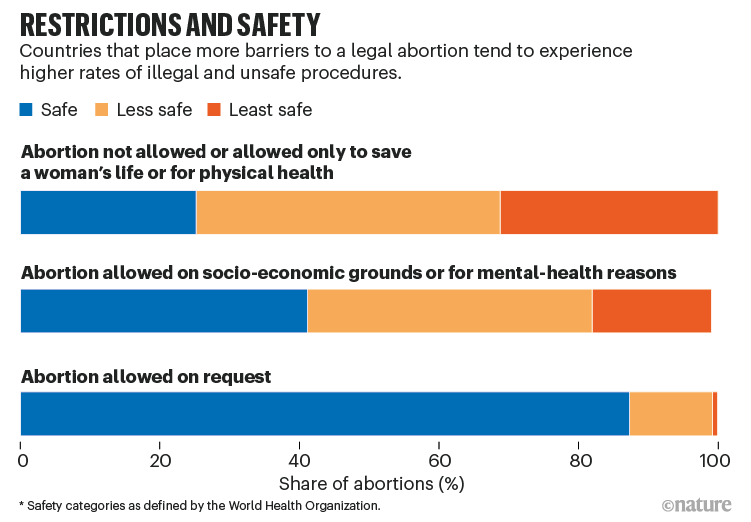
Maternal deaths are likely to rise
When carried out safely, an abortion poses less risk to a person’s health than does carrying a baby to term. As a result of reduced access, the number of pregnancy-associated deaths is expected to rise.
In a preprint study, Amanda Stevenson, a sociologist at the University of Colorado Boulder, and her colleagues modelled what would have happened in 2020 if no one had had access to abortions in 26 states that have imposed bans or are reasonably likely to do so in the future. The authors of the study made some assumptions: for example, that people who request abortions have the same age distribution as do those who have babies, and that the risk of maternal death is the same in people who have abortions as in those who don’t. With those and other limitations in mind, they estimated that if there had been no abortions in 2020, an additional 64 pregnant people would have died — an increase of 14% (see ‘Death rates rising’).
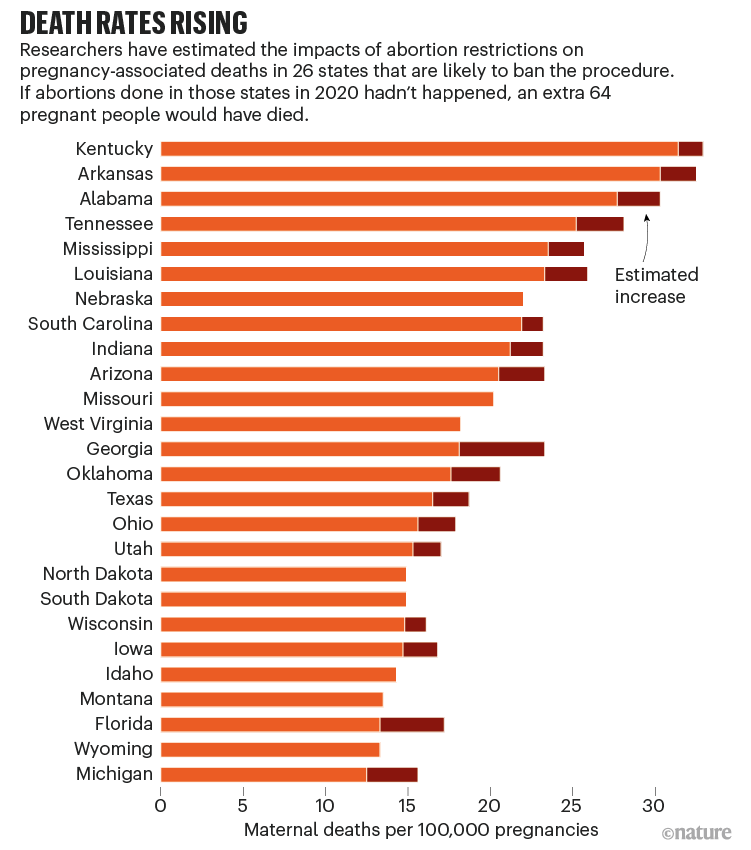
Their analyses also suggest that national death rates would be highest in non-Hispanic Black people, who already face a maternal death rate that is on average 2.9 times higher than that for non-Hispanic white people and 3.0 times higher than for Hispanic people. (US statistics typically break down racial and ethic demographics in this way.)
Almost 50 years ago, when the Supreme Court decided Roe v. Wade, epidemiologist Roger Rochat was working at the US Centers for Disease Control and Prevention (CDC) to investigate abortion deaths. It was an uplifting time, says Rochat, who now works at Emory University in Atlanta, Georgia. Liberalized abortion laws came on the heels of decriminalized contraception, giving people more opportunities to protect their reproductive health.
In 1972, the CDC received 39 reports of deaths from illegal abortions, but by 1976, this number had dropped to 2, and it has remained at or below that number since 1979. Now, with abortion regulations shifting rapidly, Rochat isn’t sure what to expect. He wonders whether maternal deaths will start increasing again, and whether the current surveillance infrastructure is even robust enough to detect an increase. “We got used to positive change,” he says. Now, “I don’t know how it’s going to shake out”.
Nature 608, 254-257 (2022) doi: https://doi.org/10.1038/d41586-022-02139-3
No comments:
Post a Comment